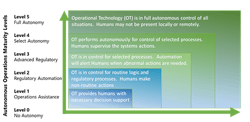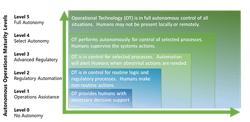Before the current COVID-19 pandemic struck, ARC Advisory Group launched an ongoing survey in conjunction with Chemical Processing’s sister magazine Control to help ascertain the current status of autonomous operations among today’s operating companies as well as the current and future levels of maturity, deployment and use.
The introduction of new digital technologies into operational technology at both the plant and enterprise levels offer the potential to augment people and processes to an unprecedented degree. Advanced functions such as artificial intelligence (AI) and machine learning (ML) are changing how people work in industry. The central question the survey attempts to answer is “What role, if any, do autonomous operations now play in manufacturing plants and other industrial facilities, and what role will they play in the future?”
End users from across the process industries have already responded to the survey, with a major contingent coming from the chemical and upstream and downstream oil & gas sectors. Although all world regions are represented, half the responses to date have been from North America.
The responses to the survey show that, currently, the best process operations are at a maturity level that, for lack of a better term, ARC defines as advanced regulatory. The majority of responses show that over the next few years, the technology will allow appropriate plant operations to be run at a level of selected autonomy. Several respondents believe that some plant operations might eventually reach full autonomy.
From a technology perspective, the ability to implement fully autonomous operations is fast approaching. However, the decision to implement this must also consider safety, reliability and cultural issues.
ARC’s Definition of Autonomous Operations
Transitioning operations from automated to completely autonomous is not a one-step process. Moreover, the transition is not simply a technology decision. In addition to safe and dependable operations, improvements to business effectiveness and value must be considered. To help industrial organizations understand where they are in the journey to autonomous operations, ARC Advisory Group has developed the following five-level model. Note that the lowest level of the model, level 0, describes operations with no automation whatsoever. In these situations, the operation is totally dependent on humans making the necessary decisions and changes to keep the operation running.
Note that different parts of an industrial plant (e.g. units, lines, etc.) are likely to be at different maturity levels. The decision to drive toward achieving autonomous operations will involve multiple factors related to available technology, personnel, processes, criticality and business importance.
Figure 1 -- Operational Technology (OT) Digital Transformation to Autonomous Operations
Levels of Autonomous Operations
Level 0 -- No Autonomy -- is the starting point on the journey to autonomous operations in the maturity model. Here, no automatic actions are occurring, with operations relying on humans to make all decisions and perform all functions. Historically, most industrial operations began with significant human intervention required to run and maintain the operations.
Level 1 -- Operations Assistance -- is common in many companies today, at least in some parts of the operations. It represents a minimum of automation technology and systems to run the operations. Instead, the OT’s primary purpose is to provide data and information for decision support, so that human operators, maintenance technicians, planners and so on can facilitate the mechanics of the operation.
Level 2 -- Regulatory Automation -- moves the degree of automatic control further along. For process industries, this includes control functions such as continuous control loops (e.g., PID control) where the automation system maintains a specific setpoint by manipulating one or more process variables. For example, the controller will manipulate a control valve, damper, pump, or motor to maintain measured process variables such as pressures, levels, flows and temperatures.
Level 3 -- Advanced Regulatory -- adds certain conditional information to the level 2 type of automation. For example, a bottle labeling line with level 2 type of automation will simply paste a label on every bottle on the conveyor. In level 3, the automation functions may be able to recognize bottles that are not full and automatically push them off the line rather than place a label on them. In the process industries, a level 3 example would be the “exception logic” built into batch controllers designed to recognize most abnormal conditions and thus not continue producing an out-of-specification batch. Level 3 type of automation, however, typically requires humans to be available for unexpected abnormalities that the automation programs were not designed to handle.
Level 4 -- Select Autonomy -- introduces the first true autonomous operations for certain situations. For example, the automation may be able to detect the imminent failure of a pump and automatically transfer operations to a standby pump. The autonomous system will notify humans both when it detects the impending failure and when it has changed the operations to the new pump. However, at this level, it still requires humans to fix the operation conditions that caused the failure. Humans would also be required to return the system to the autonomous operation state (e.g., repair or replace the failed pump.
Level 5 -- Full Autonomy -- is fully autonomous operation. At this level of automation, humans may not be needed for any intervention. Humans may be in remote locations, since their immediate presence is not required. An example of this would be a mining operation where the haul trucks operate without drivers. These vehicles would be able to detect obstacles in their path and avoid collisions while delivering the ore.
Figure 2 -- Survey Results for the Current Level of Autonomous Operation Maturity
Owner-operators Compare Autonomous Operations Maturity
Over 45 percent of owner-operators that have participated in the survey to date indicate that the current level of maturity for their best production plant facility is in the advanced regulatory category. For finished goods or product management facilities, the majority split the vote between regulatory and advanced regulatory. For other activities, such as planning and scheduling, field operations/maintenance, and raw material preparation/handling, respondents indicated a much lower level of autonomy at level 3 and below, where a significant amount of human intervention is still required. This is particularly true when unexpected events occur.
Future Outlook for Autonomous Operations
The survey also asks respondents to indicate where these segments of their operations would likely be in two years. Significantly, as the chart below indicates, most feel that while the levels of autonomy will increase, true level 5 autonomous operations will take longer than two years to come about. For the best production facility/plant, over 35 percent feel that they would be at level 4, or select autonomy, while just over 35 percent felt that level 3, or advanced regulatory would be the status.
Figure 3 -- Survey Results for the Level of Autonomous Operation Maturity in Two Years
Over 35 percent of respondents expect their operation’s handling of raw materials to be at level 3, and just over 15 percent felt it might be at level 4. Respondents have higher expectations for finished goods or product manufacturing. More than 25 percent feel that the level would be advanced regulatory, and more than 35 percent indicate they expect it to be at the select autonomy level. As the chart indicates, many respondents expect to see increased autonomy applied to the planning and scheduling, maintenance, and finished goods areas.
What Do You Think?
Due to the global COVID-19 pandemic and other factors, the world has entered a period in which new modes of operation are required. At the same time new digital transformation-enabled technologies have the potential to augment people and processes to an unprecedented degree. New, advanced functions that converge the previously separate worlds of operational technology and information technology are changing how people work in industry. As the survey indicates, there are reasons to believe that the level of autonomous operations will increase over the coming years. ARC invites professionals from across industry to participate in this brief survey by clicking here.




